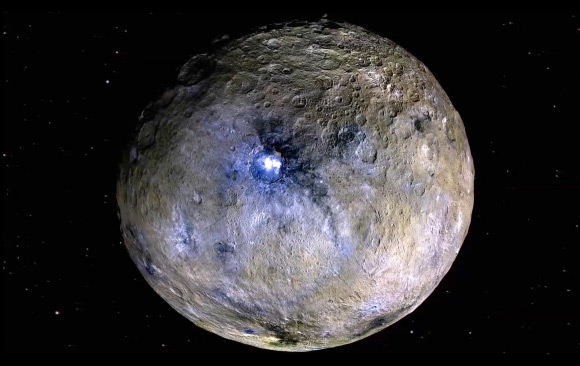Astronomers using NASA’s Infrared Telescope Facility (IRTF) telescope at Mauna Kea Observatory have captured and analyzed visible and near-infrared reflectance spectra of large and dark asteroids located in the mid-outer main asteroid belt. They found that these objects have spectral characteristics very similar to those of the dwarf planet Ceres. Their findings suggest that these main-belt asteroids were implanted from more distant regions of the Solar System during the giant planets’ dynamical instability.

This false-color image shows the dwarf planet Ceres. Image credit: NASA / JPL-Caltech / UCLA / MPS / DLR / IDA.
Dark asteroids, most of which are located in the mid-outer main belt, are thought to be leftovers from the formation of the planets and remnants of the primary accretion of the first solar system planetesimals.
These asteroids are genetically linked to carbonaceous chondrites and are collectively called primitive asteroids.
These asteroids have been studied using various observational techniques, including ground-based and space-based telescopes and spacecraft.
“These objects are the remains of the building materials from which the planets of our Solar System were created 4.5 billion years ago,” said Professor Mario Trieloff, a researcher in the Institute of Earth Sciences at Heidelberg University.
“In these small bodies and their fragments, the meteorites, we find numerous relics that point directly to the process of planet formation.”

Implantation of planetesimals into the asteroid belt during the planets’ growth and dynamical evolution. The disk’s temperature profile established a gradient in the composition of small bodies during planetesimal formation. The presence of ammoniated phyllosilicates indicates that Ceres (and presumably also the large dark planetesimals) probably originated beyond Saturn’s orbit and perhaps much farther out. Planetesimals from the Jupiter-Saturn region were implanted during the gas giants’ rapid gas accretion. The migration of the gas and ice giants caused the source region of implanted planetesimals to expand outwards. The ice giants’ growth implanted additional planetesimals. The giant planets’ instability then implanted some asteroids from the outer planetesimal disk — this is the likely source of the large dark asteroids. The instability may have been triggered by the dispersal of the gaseous disk, such that these implantation mechanisms were separated in time by only a few to ten million years. Many volatile-poor asteroids were probably implanted from the terrestrial planet-forming region. Image credit: Takir et al., doi: 10.1038/s41550-023-01898-x.
Using the IRTF telescope, Professor Trieloff and colleagues measured visible and near-infrared reflectance spectra of 10 Ceres– and Europa-like asteroids located in the mid-outer main belt and identified four main spectral groups.
“The astronomical measurements permit the identification of Ceres-like asteroids with a diameter as small as 100 km, presently located in a confined region between Mars and Jupiter near Ceres’ orbit,” said Dr. Driss Takir, an astrophysicist at NASA’s Johnson Space Center.
“At the same time, the infrared spectra support conclusions as to the bodies’ chemical and mineralogical composition.”
“Just like Ceres, there are minerals on the surface of these asteroids that originated from an interaction with liquid water.”
“High porosity is yet another characteristic shared with the dwarf planet Ceres and an indication that the rock material is still quite original.”
“Shortly after the formation of the asteroids, temperatures were not high enough to convert them into a compact rock structure,” said Dr. Wladimir Neumann, a researcher at the Technische Universität Berlin, Heidelberg University, and the Institute of Planetary Research at the German Aerospace Center.
“They maintained the porous and primitive character typical of the outer ice planets located far from the Sun.”
“The properties of these Ceres-like objects and their presence in a confined heliocentric region between about 3 and 3.4 astronomical units (AU) suggest that these bodies were probably implanted from more distant regions of the Solar System during the giant planets’ dynamical instability.”
The findings appear in the journal Nature Astronomy.
_____
D. Takir et al. Late accretion of Ceres-like asteroids and their implantation into the outer main belt. Nat Astron, published online February 20, 2023; doi: 10.1038/s41550-023-01898-x





![The image shows NGC 1866 superimposed with a false color image from the MUSE data cube, where the ionized shell of the planetary nebula Ka LMC 1 is seen as a red ring. The grayscale insets illustrate the different size of the ionized shells of singly ionized nitrogen [N II] and doubly ionized oxygen [O III]. The magnified Hubble image near the center of the ring reveals the presence of a pale blue star -- most probably the hot central star of Ka LMC 1. Image credit: AIP / M.M. Roth / NASA / ESA / Hubble.](https://cdn.sci.news/images/2025/11/image_14348-Ka-LMC-1-104x75.jpg)

